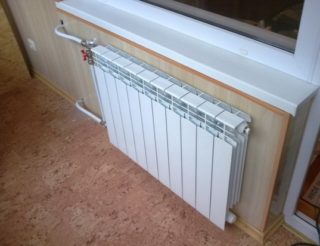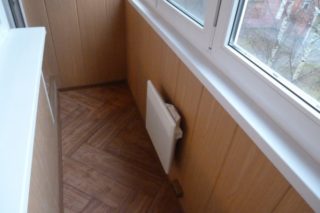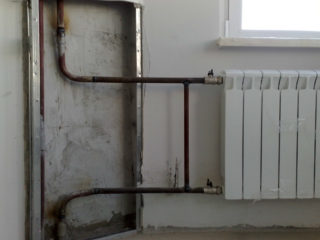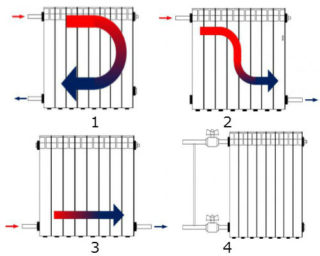The transfer of the heating radiator to the loggia is carried out when it is necessary to insulate the space when expanding the bedrooms, hall or kitchens. This will provide a more comfortable microclimate in the house and reduce heat loss with the advent of cold weather. However, this is not an easy task. First you need to calculate and design everything correctly, then approve by specialists of service organizations.
Nuances of radiator removal to the balcony

At the design stage of a residential building, many criteria are taken into account: the working temperature of the coolant and the number of batteries installed in the house, the internal system pressure. As soon as an additional battery is installed in the loggia, the pressure in the closed circuit and the temperature of the coolant drops.
If the project has 100 radiators installed, and 101 becomes, the changes will be imperceptible. But if most homeowners decide to move the radiators to the balcony, the temperature in the apartments in winter will be several degrees lower. Therefore, it is difficult to obtain special permission to carry out these works.
If the temperature in the loggia drops below zero, it is possible to clog the system due to freezing of water in the pipes, rupture of the heating radiator. In this case, you will have to restore the system and pay a fine for an administrative offense. Therefore, it is recommended that alternative heating methods be considered.
If you decide to still transfer the heating devices, you need to be patient for the implementation of the following steps:
- Carrying out engineering calculations of the thermal conductivity of the insulation.
- Obtaining a conclusion from a specialist that freezing the system is impossible even at abnormally low temperatures outside the window.
- Obtaining permission to install a radiator in the loggia.
- Directly install.
As an alternative method of heating the area, you can use infrared and / or oil heaters, air conditioners and electric converters. It is forbidden to use gas and solid fuel stoves on the balconies of apartment buildings, because if the operating rules are not followed, this can be explosive and fire hazard.
How to choose a battery on the balcony
The most preferred option for working on the balcony is aluminum sectional batteries. They are considered the most effective due to their increased surface area and high thermal conductivity. Lightweight and support / withstand system pressure.
Different manufacturers indicate different indicators of heat transfer, but the difference is negligible. You need to be a specialist in this industry to understand the differences in the technical characteristics of the proposed modifications.
Counting rules required number of sections
There are universal rules for calculating the required number of sections:
- One section of an aluminum radiator can heat no more than 2 sq.m., and bimetallic batteries - 1.5 sq.m.
- To calculate the optimal amount, you need to divide the area of the loggia by 2 or 1.5 (depending on which batteries will be used).
Experts recommend additionally installing 1-2 sections in case the coolant in the system is not very hot.
Radiator mounting
It is difficult to independently carry out all installation work without experience. To save money and time, it is better to invite a professional plumber to do the work.If this option is excluded, and the work will be carried out independently, you need to prepare a working inventory:
- sealant;
- Mayevsky crane;
- welding machine;
- control and shut-off valves;
- roulette;
- futor nuts and plugs;
- die and vise;
- pipes;
- hammer drill;
- Bulgarian;
- fitting.
Before proceeding with the installation, you need to decide on what scheme the connection will be made. It is better to give preference to a method with a jumper, since it allows you to perform any manipulations with the battery in winter and summer.
Connection is carried out according to the following technology:
- Connection to the main pipe. Using a grinder, make small cuts on the outside of the thread on the pipes and fasten them with fittings that have additional branches. To ensure waterproofing, use a fum tape or tow.
- Through holes in the wall, pipes are laid with threads applied to them. They should protrude approximately 8–9 cm from the wall. A corner fitting is attached to the second end of the pipe, which must occupy a strictly vertical position in space.
- Hang the radiator. It is necessary to mark on the wall with a pencil the places where the brackets will be attached. Using a punch, a hole is made in the wall and the bracket is fixed.
- The battery is fixed by laying a rubber washer between the parts and the bracket.
- With the help of a building level, the location of the radiator is regulated.
- Connects the eyeliner. Two pipes about 25-30 cm long are discharged from the radiator, one end is connected to the battery, and the other is closed by a fitting.
- In conclusion, they begin the vertical installation of pipes, which are necessary for the supply and removal of coolant from the radiator. They are screwed into the finished fittings, all connections must be tight.
When carrying out construction work, it is preferable to use polypropylene plastic pipes, which are connected by fittings by soldering. To make the system more efficient, it is recommended to install foil heat-reflecting screens on the wall behind the batteries.





